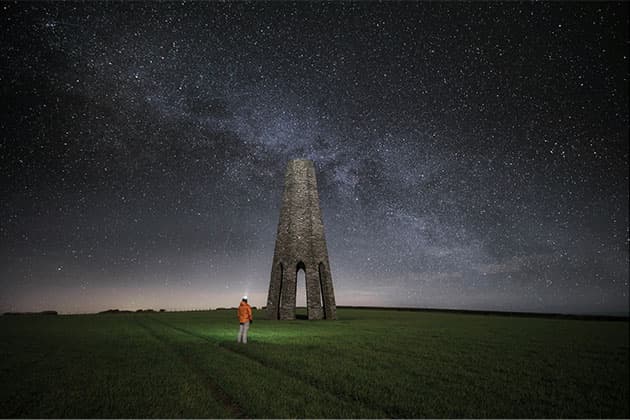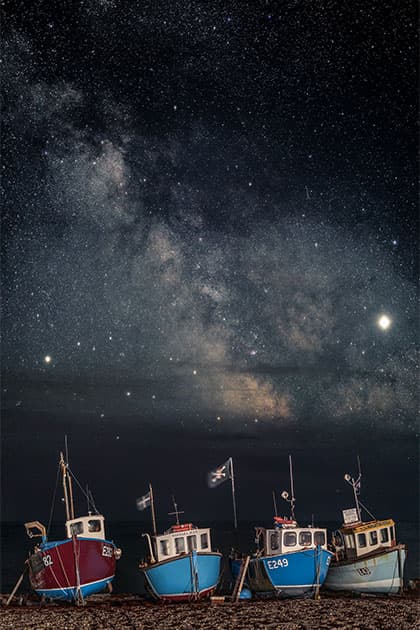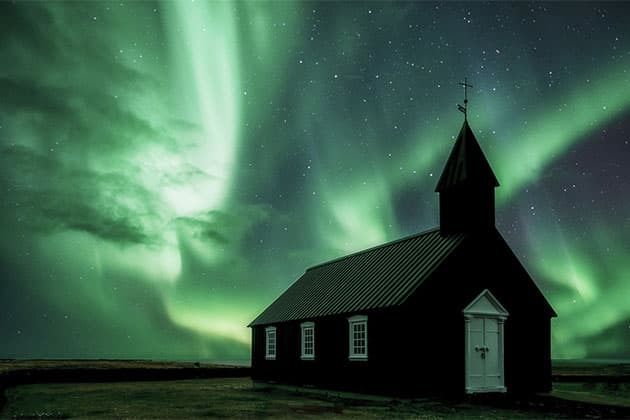
‘Day/Night Marker’, Devon. Sony Alpha 7R, 14mm lens, 20sec at f/2.8, ISO 2500. Credit: Andrew Campbell
The Photographer of the Year competition organised by Wex Photo and Video via social media is one of the most interesting and challenging contests of the photographic year. To succeed you need to post images very regularly on social media, so it’s not for the lazy or faint-hearted. The Wex Photographer of the Year 2020 is Andi Campbell from Devon, who specialises in beautifully composed landscapes (and seascapes) featuring the Milky Way. We caught up with Andi to get the full story.
We are all made of stars
‘Astrophotography has always been an interest, but I noticed I was developing a specific style, whereby the stars were secondary to other aspects of the image – particularly the foreground,’ Andi explained when we met him at the Wex Photo Video flagship store in London. ‘That is why my most successful images feature the Milky Way behind St Michael’s Mount, boats in the harbour, or other elements. When people look at my pictures they are surprised to see a “normal” landscape subject with the Milky Way behind it.’
A key influence on Andi was the noted astrophotographer Alyn Wallace, but Andi is much more than a tribute act. ‘While he would capture the whole of the Milky Way or a nebula, I wanted to capture stars working with other elements in the frame.’
Andi is adamant that it’s really important in this kind of photography to understand where the Milky Way is going to be and to work out the weather – in other words, to do a lot of planning in advance. ‘Understanding the rule of 500 is crucial, so the stars are not overly blurred or moving in the image,’ he explains. ‘Put simply, you take the focal length of your lens and divide 500 by that number. This gives you the maximum amount of seconds you can keep your shutter open when capturing the shot. This has interesting implications for me, as I tend to shoot with less wideangle lenses, with 24mm and 50mm being my normal lens length. This is quite uncommon in astrophotography, as most people are shooting as wide as they can.’

‘Space Pirates’, Beer, Devon. Sony Alpha 7R III, 50mm, 8sec at f/1.8, ISO 2500, Kase SGND filter. Credit: Andrew Campbell
Space Pirates
For ‘Space Pirates’, one of Andi’s most popular images, he used a Sony 50mm lens with a fast aperture of f/1.8. ‘The rule of 500 meant I could keep the shutter open for ten seconds, and the wide aperture really helped make the most of the available light.’ For the final image, Andi took three vertical images at the same exposure and then merged them in Lightroom.
‘Another shot that did well in the competition this year was of St Michael’s Mount in Cornwall. Again, 50mm was the right lens length to get the monument in the right balance; if you shoot too wide, the subject disappears. The Mount is the subject, and the stars complement it, so it didn’t matter so much that the image was not so sharp at the edges, which tends to happen when using a prime lens at a wider aperture. Unless you are looking at the edges with a magnifying glass, does it matter?’
As mentioned, Andi will often take three vertical images if longer focal lengths mean he can’t get the whole of the scene in one shot, and then merge them in software. ‘If you capture the Milky Way in enough light and detail, software will happily merge the images for you. I don’t feel the need for bespoke panoramic software or a star tracker, I just have a tripod and ball head. The only extra tools I use are filters.’

‘Milky St Michael’s’, Cornwall. Sony Alpha 7R III, 50mm, 10sec at f/1.8, ISO 1250, Kase Neutral Night filter. Credit: Andrew Campbell
Andi is associated with Kase Filters, and swears by its neutral night filter for helping to control the effect orange sodium lights. He says, ‘With “Space Pirates”, the boats were illuminated so brightly that I had to use a graduated filter in reverse to capture the scene. I used a medium-edge grad upside down so I could expose for the boat and the stars at the same time.’
Gear aside, Andi also stresses the importance of location when trying to perfect his style of astrophotography. ‘Being based in Devon is a big advantage,’ he notes. ‘In May onwards, the south Devon coastline is looking out towards the Milky Way with nothing until you get to France, so there is not much light pollution. You need virtually clear skies for this kind of phototography, as dark as you can get. In the UK the best locations for naturally dark skies include the South West, Snowdonia, the Brecon Beacons, the Scottish Highlands and Kielder Forest in Northumberland.’

‘Coastal Dream’, Devon. Sony Alpha 7R III, 24mm, 20sec at f/2.8, ISO 2500. Credit: Andrew Campbell
More light, less noise
Returning to technical tips, Andi reckons the biggest challenge in his kind of scenic astrophotography is capturing enough light and fighting against noise. ‘You have to balance the two. Because of the rule of 500 you know the maximum time you can expose the image for before the stars start to trail. Then I try to balance how much light I can capture for the shortest possible time, at the lowest possible ISO. I tend to use ISO 2500, which is as far as I like to push it on larger full-frame cameras not speci cally designed for astrophotography. I have taken good images at ISO 3200, however. The more light the stars generate, the easier it is.’
When it comes to aperture, Andi tends to work between f/1.8 and f/2.8, again to suck in as much light from the nocturnal scene as possible. ‘I also shoot in manual focus and turn off image stabilisation – I shoot on a tripod, so I don’t need it.’
A big mistake beginners make with this kind of photography is to try to capture too much and forget about foreground interest. ‘They will see the Milky Way in the sky but forget that the way our brains are programmed is to look at an image from the bottom up, so you need an element to lead you into the image. All the best Milky Way images will have a mountain in, or a single tree, to provide context and extra visual interest. You can have a technically successful image of the Milky Way that just isn’t very interesting to look at.’
Andi always shoots in raw to give maximum latitude at the editing stage, making sure the foreground interest is perfect and the core of the Milky Way really ‘pops’ out of the frame. As for the future, he is keen to visit Peru, Turkey and Oregon. ‘My dream location is Easter Island, as you have the statues and there is no light pollution.’

‘Electric Skies’, Iceland. Sony Alpha 7R, 16-35mm, 5sec at f/2.8, ISO 2000. Credit: Andrew Campbell.
Reach for the stars
Andi’s current camera of choice is a Sony Alpha 7R III. ‘I have only ever shot mirrorless, as I only seriously got into photography around 2014-15, starting out with Samsung. I upgraded to the original Sony A7R, bought second-hand from Wex Photo Video. When the Sony A7R III came out, I felt it was time to upgrade. It’s a great camera and does more than I need it to. I’d actually recommend the Sony A7 III as being better for my kind of work as the sensor generates less noise.’
For lenses, Andi mainly uses a Samyang 24mm f/1.8, a Samyang 14mm f/2.8, and a Sony 50mm f/1.8. ‘Each lens cost lens than £400. I am a rm believer in sometimes buying second-hand. On “Space Pirates” I used a Kase Wolverine inverted 3 stop soft grad, and Kase Wolverine neutral night filter on the image of St Michael’s Mount, as some ships were giving off orange sodium light.’
How to do well in Wex POTY
‘Because this contest is judged by so many people, you have to appeal to a lot of different eyes,’ says Andi. ‘Make sure your images are technically sound – you need to understand the rules of photography before you break them – and plan in advance. I entered 40 times in the year, and had more failures than winners, but entering made me a better photographer.’ Andi reckons there is a great online community around the competition. ‘A few of the other entrants have become friends, and the Twitter community is really helpful and encouraging. Twitter works better for me for than other social media as you get peer feedback.’
Andi Campbell is a landscape photographer based in Devon. ‘My passion is capturing a moment of time and turning that into art,’ he says. The South West of England plays a major part in his portfolio of work.









